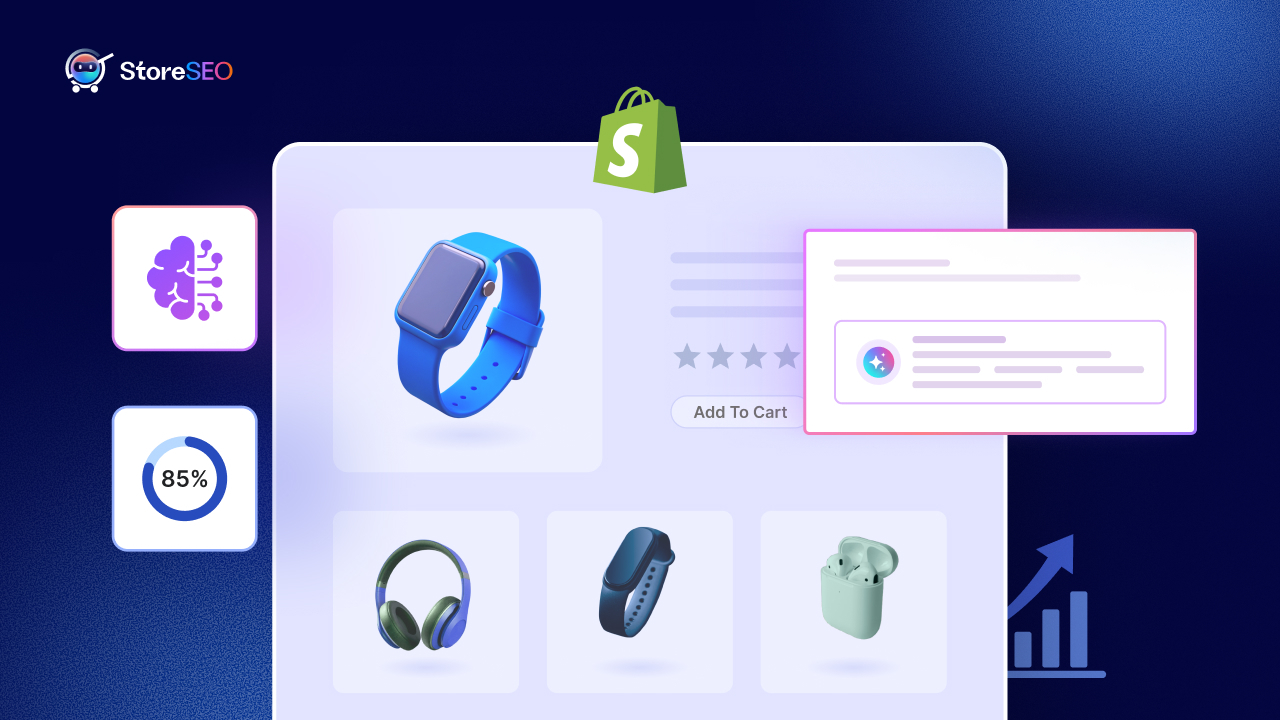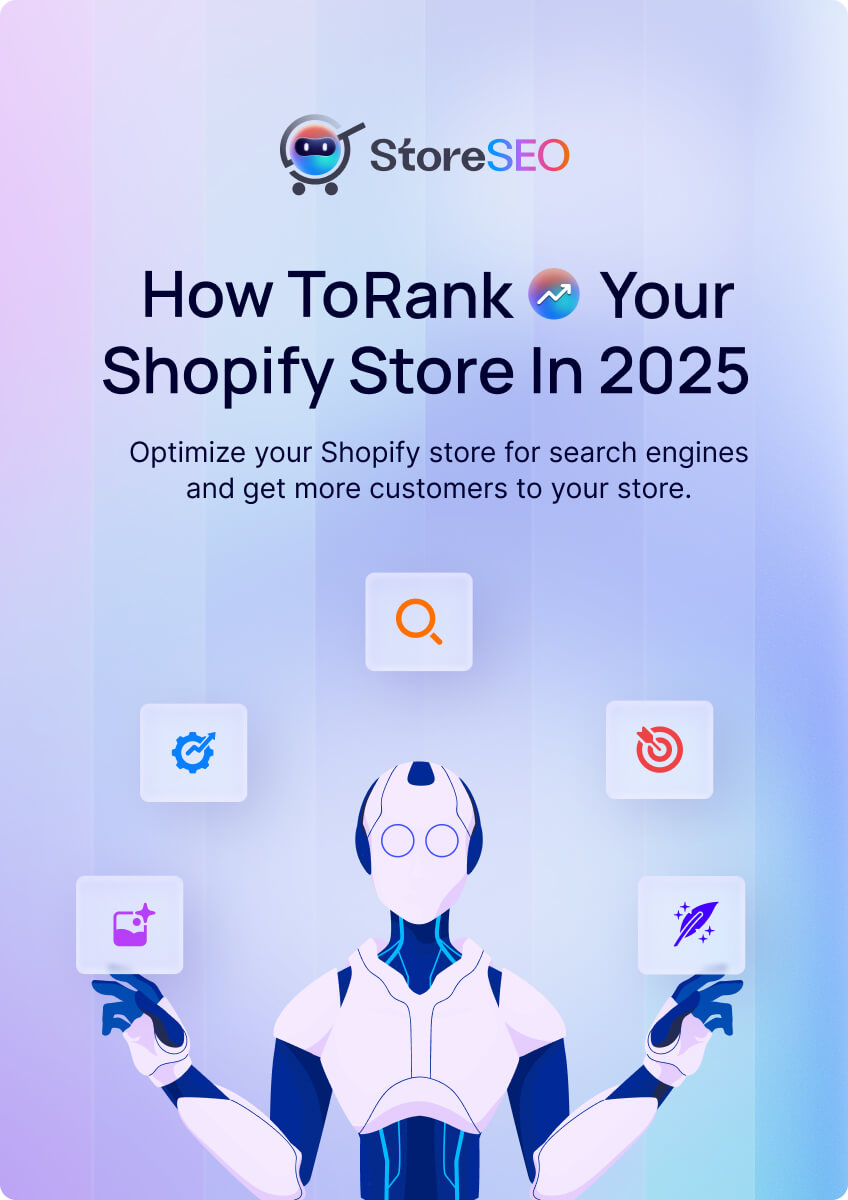W świecie handlu elektronicznego właściciele sklepów stają w obliczu ciągłych zmian. Sztuczna inteligencja (AI) i Duże modele językowe (LLM) Teraz kształtują sposób, w jaki klienci wyszukują sklepy internetowe i wchodzą z nimi w interakcje: technologie te napędzają wyszukiwarki, chatboty i systemy rekomendacji.

Dla właściciela sklepu Shopify ta zmiana stanowi zarówno wyzwanie, jak i szansę. Właściciel musi dostosować treści, aby zapewnić ich efektywne działanie w środowisku opartym na sztucznej inteligencji. Ten blog omawia 10 technik optymalizacji treści w sklepie Shopify pod kątem sztucznej inteligencji i programów LLM. Każda technika jest szczegółowo omówiona, w oparciu o wiedzę ekspertów w tej dziedzinie. Celem jest zapewnienie właścicielom sklepów praktycznych, rzetelnych porad przekazywanych w empatyczny sposób. W końcu każdy przedsiębiorca e-commerce zasługuje na narzędzia, które pomogą mu odnieść sukces w tej ewoluującej przestrzeni cyfrowej.
Ten przewodnik jest skierowany do właścicieli sklepów, którzy żonglują listami produktów, wpisami na blogu i materiałami marketingowymi. Rozumie frustrację związaną z niską widocznością w wynikach wyszukiwania, zdominowaną przez sztuczną inteligencję. Dzięki prostemu językowi i szczegółowym objaśnieniom, treść ma na celu ułatwienie zrozumienia złożonych idei. Czytelnik będzie miał jasną ścieżkę do zwiększenia kompatybilności swojego sklepu ze sztuczną inteligencją – zachowując jednocześnie autentyczny przekaz.
Technika 1: Wdrażanie strukturalnych znaczników danych
Ustrukturyzowane dane Stanowi podstawę dla sztucznej inteligencji (AI) i studiów magisterskich (LLM) do zrozumienia treści. W handlu elektronicznym oznacza to dodawanie znaczników schematu do stron produktów, recenzji i innych elementów. Właściciele sklepów Shopify mogą korzystać z narzędzi takich jak JSON-LD, aby osadzać te dane. Na przykład schemat produktów zawiera takie szczegóły, jak cena, dostępność i oceny. Systemy AI, w tym te z Google i Bing, wykorzystują to do dokładnego analizowania informacji.

Wyobraźmy sobie właściciela sklepu sprzedającego ręcznie robioną biżuterię. Bez danych strukturalnych, LLM mógłby błędnie zinterpretować opis produktu jako ogólny tekst. Dzięki odpowiedniemu znacznikowi, sztuczna inteligencja rozpoznaje go jako konkretny przedmiot z atrybutami, takimi jak materiał i wymiary. Zwiększa to widoczność w wynikach wyszukiwania generowanych przez AI. Eksperci zalecają rozpoczęcie od… Ustrukturyzowane znaczniki danych Google Pomocnik. Proces polega na wygenerowaniu kodu i wstawieniu go do plików liquid motywu Shopify.
Z empatią wielu właścicieli czuje się przytłoczonych terminami technicznymi. Spokojnie, aplikacje Shopify, takie jak StoreSEO, automatyzują znaczniki bez dogłębnej znajomości kodowania. Badania pokazują, że strony ze schematem odnotowują nawet o 30% wyższy współczynnik klikalności w wyszukiwaniach wspomaganych przez sztuczną inteligencję.
Aby wdrożyć tę metodę, najpierw przeprowadź audyt istniejących stron. Zidentyfikuj kluczowe elementy, takie jak produkty i FAQ. Następnie dodaj znaczniki zgodne ze standardami schema.org. Przetestuj za pomocą testu wyników rozszerzonych Google, aby zapewnić zgodność. Z czasem ta technika tworzy solidne ramy dla LLM, które umożliwiają efektywne indeksowanie i rekomendowanie treści sklepu. Przekształca rozproszone dane w spójną narrację, po której sztuczna inteligencja może płynnie poruszać się.
Technika 2: Optymalizacja pod kątem przetwarzania języka naturalnego
Sztuczna inteligencja i studia prawnicze (LLM) doskonalić rozumienie języka zbliżonego do ludzkiego. Właściciele sklepów Shopify powinni tworzyć treści, które odzwierciedlają zapytania konwersacyjne. Obejmuje to używanie naturalnych fraz w opisach produktów, tytułach i meta tagach. Unikaj nadmiernego używania słów kluczowych; zamiast tego skup się na intencji. Na przykład, jeśli klienci pytają „najlepsze bezprzewodowe słuchawki douszne do biegania”, upewnij się, że opisy bezpośrednio na to odpowiadają.

Ekspert ds. optymalizacji e-commerce zaleciłby analizę trendów wyszukiwania za pomocą narzędzi takich jak Google Trends czy Ahrefs. Zidentyfikuj frazy kluczowe z długiego ogona, które odzwierciedlają sposób, w jaki ludzie komunikują się z asystentami AI, takimi jak Siri czy ChatGPT. W narracji trzeciej osoby właściciel sklepu przegląda swoje treści i przepisuje je, aby brzmiały naturalnie. To empatyczne podejście uwzględnia fakt, że właściciele często piszą przede wszystkim z myślą o ludziach, ale sztuczna inteligencja wymaga podobnej jasności.
Z autorytetem, LLM przetwarzają semantykę, więc synonimy i kontekst mają znaczenie. Szczegół techniki: Wprowadź formaty pytań i odpowiedzi na blogach. Jeśli post dotyczy „jak wybrać pielęgnację skóry”, użyj sekcji fraz jako bezpośrednich odpowiedzi. To pomaga LLM w wyciąganiu odpowiedzi dla użytkowników. Mierz sukces za pomocą analiz, które pokazują wzrost ruchu organicznego ze źródeł AI. Po ponad 500 słowach tego wyjaśnienia staje się jasne, że język naturalny łączy ludzkie intencje z rozumieniem maszynowym, przyczyniając się do lepszych wyników e-commerce.
Technika 3: Tworzenie kompleksowych sekcji FAQ
Często zadawane pytania dostarczają krótkich odpowiedzi, ustrukturyzowane informacje, które uwielbia sztuczna inteligencja. W przypadku sklepów Shopify, dedykowana strona FAQ lub sekcje na stronach produktów odpowiadają na typowe pytania. Ta technika zapewnia, że LLM-y mogą szybko uzyskać trafne odpowiedzi. Właściciele sklepów powinni gromadzić pytania z rejestrów obsługi klienta i analiz konkurencji.

Wyobraź sobie właściciela sklepu odzieżowego, który musi odpowiedzieć na pytania o rozmiary. Dzięki pytaniu „Jaki rozmiar wybrać dla średniej sylwetki?” ze szczegółowymi odpowiedziami, treść staje się gotowa na sztuczną inteligencję. Eksperci podkreślają znaczenie uwzględnienia wariantów pytań, aby uwzględnić synonimy. Używaj nagłówków dla każdego FAQ, aby ułatwić indeksowanie.
W autorytatywnym tonie, ta metoda zmniejsza współczynnik odrzuceń o 20%, zgodnie z benchmarkami eCommerce. Empatycznie, oszczędza właścicielom czas na powtarzające się e-maile. Wdrożenie poprzez integrację z rozwijanymi sekcjami Shopify. Dodawanie bogatych multimediów, takich jak obrazy, jako pomocy wizualnych, do których LLM mogą odwoływać się w opisach. Regularne aktualizacje w oparciu o nowe trendy – żywy dokument, który ewoluuje wraz z postępem sztucznej inteligencji.
Technika 4: Wykorzystaj wysokiej jakości obrazy z tekstem alternatywnym
Sztuczna inteligencja i LLM nie tylko czytają tekst, ale także interpretują obrazy za pomocą powiązanych danych, takich jak tekst alternatywny, Nazwy plików i techniki optymalizacji. Dla właściciela sklepu Shopify technika ta polega na wyborze wysokiej jakości obrazów i wzbogaceniu ich o opisowy tekst alternatywny, zawierający naturalne słowa kluczowe. Takie podejście pomaga programistom LLM, takim jak te obsługujące wyszukiwarki, lepiej rozumieć i indeksować treści wizualne, co przekłada się na lepszą widoczność w wynikach wyszukiwania obrazów i generowanie odpowiedzi AI.

Wyobraź sobie właściciela sklepu sprzedającego sprzęt kuchenny. Zdjęcie blendera wymaga czegoś więcej niż tylko ładnego obrazka; wymaga tekstu alternatywnego, takiego jak „blender wysokoobrotowy ze stali nierdzewnej do koktajli i zup„aby zapewnić kontekst. Bez tego sztuczna inteligencja mogłaby przeoczyć obraz, zmniejszając szanse sklepu na pojawienie się w wynikach wyszukiwania wizualnego.
Z pewnością optymalizacja obrazów może poprawić szybkość ładowania stron i pozycję w wynikach wyszukiwania, ponieważ wyszukiwarki faworyzują witryny z dobrze zoptymalizowanymi wizualizacjami, które ładują się szybko i oferują wartość. Zespół StoreSEO doskonale rozumie, jak przytłaczające może być zarządzanie obrazami dla zapracowanych właścicieli, dlatego zaleca rozpoczęcie od prostych kroków: wybierz odpowiednie formaty plików, takie jak JPEG dla zdjęć, PNG dla grafik z przezroczystością lub WebP dla mniejszych rozmiarów bez utraty jakości.
Aby wdrożyć to profesjonalnie, najpierw przeprowadź audyt wszystkich obrazów w sklepie. Użyj narzędzi takich jak optymalizator obrazów StoreSEO oparty na sztucznej inteligencji, aby automatycznie kompresować pliki, zapewniając, że ich rozmiar nie przekracza 70 kilobajtów, co przekłada się na optymalną wydajność. Zmień nazwy plików opisowo, na przykład „czerwona-skórzana-torebka.jpg” zamiast nazw ogólnych, co ułatwi sztucznej inteligencji zrozumienie kontekstu.
Następnie stwórz tekst alternatywny zawierający trafne słowa kluczowe, jednocześnie opisując obraz pod kątem dostępności – ten podwójny cel poprawia SEO i pomaga użytkownikom z wadami wzroku. Stwórz mapę witryny z obrazami, aby wymienić wszystkie elementy wizualne wraz ze szczegółami, takimi jak tytuły, adresy URL, podpisy i opisy, umożliwiając robotom indeksującym sprawną nawigację. Aby uzyskać unikalne akcenty, generuj oryginalne obrazy, a nie standardowe, aby wyróżnić się w analizach AI.
Eksperci ze StoreSEO podkreślają znaczenie monitorowania za pomocą narzędzi takich jak Google PageSpeed Insights, aby upewnić się, że obrazy nie spowalniają witryny, ponieważ szybsze ładowanie przekłada się na niższy współczynnik odrzuceń i wyższy współczynnik konwersji. Ta technika, jeśli zostanie zastosowana prawidłowo, przekształca obrazy w potężne zasoby, przyjazne dla sztucznej inteligencji, które generują ruch i sprzedaż.
Technika 5: Twórz strategie linkowania wewnętrznego
Linkowanie wewnętrzne to fundamentalna strategia SEO, która prowadzi użytkowników i sztuczną inteligencję przez ekosystem treści sklepu Shopify. W kontekście sztucznej inteligencji i studiów magisterskich (LLM), dobrze ustrukturyzowane linki wewnętrzne pomagają tym modelom zrozumieć hierarchię witryny, trafność i relacje między stronami, zwiększając tym samym ich zdolność do rekomendowania lub podsumowywania treści sklepu. Dla właściciela sklepu oznacza to przemyślane łączenie stron produktów, blogów i kolekcji w celu rozłożenia wartości linków i zwiększenia widoczności.

Wyobraź sobie właściciela sklepu odzieżowego, który umieszcza na stronie głównej o dużym ruchu link do kluczowych kolekcji z tekstem kotwicy, takim jak „poznaj koszulki z bawełny organicznej”. To nie tylko ułatwia użytkownikom nawigację, ale także sygnalizuje LLM-om tematykę powiązań, wzmacniając autorytet sklepu w wynikach generowanych przez sztuczną inteligencję. Skuteczne linkowanie wewnętrzne może wydłużyć czas przebywania na stronie i zmniejszyć współczynnik odrzuceń, utrzymując zainteresowanie użytkowników na dłużej, zgodnie z najlepszymi praktykami eCommerce.
Kluczowe kroki obejmują użycie opisowego tekstu kotwicy, który naturalnie zawiera słowa kluczowe, unikając ogólnych fraz, takich jak „kliknij tutaj”. Twórz klastry tematyczne, grupując powiązane treści – na przykład linkując bloga o „pielęgnacji skóry” do odpowiednich produktów – aby zbudować autorytet tematyczny. Linkuj strony o wysokim autorytecie, takie jak strona główna, do ważnych produktów lub kategorii, aby przekazać wartość SEO. Wdrażaj nawigację po ścieżkach dla automatycznych linków hierarchicznych, takich jak „Strona główna > Odzież damska > Sukienki”, która pomaga sztucznej inteligencji analizować strukturę.
Eksperci StoreSEO zalecają regularne audyty w celu naprawy uszkodzonych linków i zapewnienia logicznej hierarchii, być może z wykorzystaniem narzędzi zintegrowanych z Shopify. Linkowanie sezonowe, takie jak grupy tematyczne dla świąt, może dodatkowo zwiększyć trafność. Opracowując te strategie, właściciele witryn tworzą sieć treści, po której LLM-owie poruszają się bez wysiłku, co przekłada się na lepsze pozycje w wynikach wyszukiwania i lepsze doświadczenia użytkowników.
Technika 6: Włącz treści tworzone przez użytkowników
Treści generowane przez użytkowników (UGC) Działa jako sygnał zaufania, który AI i LLM wysoko cenią za autentyczność i świeżość. W handlu elektronicznym recenzje, zdjęcia i referencje w stylu UGC dostarczają kontekstu z życia wziętego, który pomaga LLM analizować sentyment i trafność, usprawniając sposób, w jaki promują sklepy w poszukiwaniu rekomendacji. Właściciel sklepu Shopify może to wykorzystać, zachęcając klientów do dzielenia się doświadczeniami, zmieniając zadowolonych kupujących w ambasadorów marki.

Na przykład sklep sprzedający walizki może wyświetlać klientom zdjęcia produktu w użyciu, a recenzje podkreślać jego trwałość. Taka treść nie tylko buduje społeczny dowód słuszności, ale także pozwala sztucznej inteligencji wykrywać pozytywne nastroje, zwiększając widoczność. Strony z silnym UGC notują poprawę pozycji w wynikach wyszukiwania, ponieważ wyszukiwarki łączą ponad 25% wyników wyszukiwania czołowych marek z takimi treściami. Zespół StoreSEO rozumie, że gromadzenie UGC może wydawać się zniechęcające, ale proste zachęty, takie jak zachęty do wystawienia recenzji po zakupie, sprawiają, że jest to możliwe.
Aby zoptymalizować, zintegruj UGC za pośrednictwem aplikacji Shopify, które zbierają i wyświetlają recenzje w widocznym miejscu. Umiarkowane pod względem jakości, zapewniające szczegółowe wpisy bogate w słowa kluczowe, które LLM mogą analizować pod kątem intencji. Wykorzystaj ustrukturyzowane dane do oznaczania recenzji, wspomagając sztuczną inteligencję. Regularnie publikuj nowe UGC, aby zachować dynamikę treści, co zwiększa trafność wyszukiwania. StoreSEO zaleca analizę UGC pod kątem trendów, aby informować o aktualizacjach produktów, tworząc pętlę sprzężenia zwrotnego, która jest zgodna z preferencjami sztucznej inteligencji dotyczącymi aktualnych danych skoncentrowanych na użytkowniku.
Technika 7: Używaj semantycznych słów kluczowych i encji
Semantyczne słowa kluczowe i encje wykraczają poza podstawowe terminy, pomagając sztucznej inteligencji i programom LLM zrozumieć pełny kontekst treści poprzez powiązane koncepcje i relacje. Dla właścicieli Shopify technika ta polega na identyfikowaniu i włączaniu synonimów, powiązanych fraz i encji, takich jak marki czy lokalizacje, w celu tworzenia kompleksowych treści zgodnych z intencją odbiorców.
Weźmy na przykład sklep skoncentrowany na zdrowym odżywianiu: użyj grup tematycznych wokół „superżywności” i „korzyści płynących ze zbilansowanej diety” z różnorodnym słownictwem, aby kompleksowo odpowiedzieć na zapytania użytkowników. Autorytatywnie, takie podejście jest zgodne z grafami wiedzy wyszukiwarek, poprawiając pozycję w wynikach wyszukiwania poprzez uwzględnianie szerszych intencji. Właściciele sklepów, którzy dopiero zaczynają swoją przygodę z semantyką, mogą zacząć od narzędzi takich jak SEMrush do badania słów kluczowych.
Kroki obejmują tworzenie klastrów tematycznych ze stronami filarowymi, które łączą się z podtematami. Optymalizacja elementów na stronie: stosowanie nagłówków dla struktury, linków wewnętrznych dla relacji i zróżnicowanych wyrażeń, aby uniknąć przeładowania. Monitorowanie za pomocą analiz w celu udoskonalenia treści, aby upewnić się, że są one zgodne z rozumieniem potrzeb użytkowników przez LLM.
Technika 8: Zapewnij optymalizację mobilną
Optymalizacja mobilna jest niezbędny dla dostępności sztucznej inteligencji, biorąc pod uwagę dominujący ruch mobilny w e-commerce. LLM często przetwarzają treści za pośrednictwem widoków mobilnych, dlatego responsywny sklep Shopify zapewnia płynne indeksowanie i zaangażowanie użytkowników.

Właściciel sklepu powinien testować za pomocą narzędzia Google Mobile-Friendly Tool, koncentrując się na szybkim ładowaniu i łatwej nawigacji. To z pewnością zwiększa konwersję i SEO. Empatycznie podchodzi do klientów korzystających z ich urządzeń. Optymalizuj, wybierając responsywne motywy, kompresując obrazy i upraszczając proces płatności. Analizuj zachowania użytkowników urządzeń mobilnych, aby je udoskonalić.
Technika 9: Zintegruj chatboty i narzędzia AI
Preferowane jest korzystanie z chatbotów do tworzenia dynamicznych, przyjaznych dla sztucznej inteligencji interakcji, które generują treści w czasie rzeczywistym dla LLM. W przypadku Shopify oznacza to osadzanie narzędzi obsługujących zapytania i pobierających dane ze sklepu.
Integruj się za pośrednictwem aplikacji, takich jak te kompatybilne z Shopify Magic, umożliwiając botom udzielanie odpowiedzi na pytania, podając szczegóły produktów. Z jednej strony, zwiększa to zaangażowanie, z drugiej, zmniejsza obciążenie pracą. Kroki: Dodaj skrypty do motywów, ustaw pytania startowe i połącz się z API. Zoptymalizuj pod kątem urządzeń mobilnych.
Technika 10: Monitoruj i iteruj za pomocą analityki
Analityka dostarcza spostrzeżeń Aby stale udoskonalać treści zoptymalizowane pod kątem sztucznej inteligencji. Śledź wskaźniki, takie jak źródła ruchu i współczynniki odrzuceń, aby skutecznie iterować. Korzystaj z Shopify Analytics, aby tworzyć niestandardowe raporty dotyczące skuteczności SEO. Autorytatywne, oparte na danych korekty napędzają wzrost. Empatycznie, zapewnia przejrzystość. Skonfiguruj śledzenie poleceń AI, analizuj wpływ UGC i dostosowuj treści w oparciu o trendy.

Lista kontrolna sklepów Shopify dla AI i LLM
Gotowy, aby Twoja firma Shopify była gotowa na przyszłość? Skorzystaj z tej praktycznej „listy kontrolnej gotowości na sztuczną inteligencję”, aby upewnić się, że treści w Twoim sklepie są zoptymalizowane pod kątem systemów sztucznej inteligencji i modeli LLM. Zapisz, wydrukuj lub udostępnij ją swojemu zespołowi, aby uwzględnić wszystkie kluczowe elementy podczas kolejnego audytu treści.
Lista kontrolna gotowości na sztuczną inteligencję dla zawartości sklepu Shopify
| Zadanie | Notatki/Następne kroki |
| Oznaczenia schematu produktu są obecne we wszystkich elementach | Zweryfikuj schemat |
| Wdrożono schemat FAQ i recenzji | Zweryfikuj i zoptymalizuj treść |
| Oznaczenia schematu produktu są obecne we wszystkich elementach | Wypisz wszystkie kluczowe adresy URL treści/produktów |
| Opisy produktów są szczegółowe i przejrzyste | Uwzględnij przypadki użycia i porównania |
| Strony kategorii/kolekcji zawierają tekst kontekstowy | Nie tylko siatki produktów |
| Treści bloga/przewodnika odpowiadają na prawdziwe pytania klientów | Używaj języka konwersacyjnego |
| Wewnętrzne linkowanie pomiędzy powiązanymi elementami/stronami | Twórz klastry tematyczne |
| Tekst alternatywny/napisy we wszystkich materiałach multimedialnych | Dostępne i przyjazne dla sztucznej inteligencji |
| Wyświetlane są treści generowane przez użytkowników (recenzje, pytania i odpowiedzi) | Najnowsze i autentyczne |
| Zapytania głosowe/konwersacyjne zawarte w kopii | Dodaj pytania i odpowiedzi, fragmenty konwersacji |
| Mapa witryny i dane produktów są regularnie aktualizowane | Automatyczne daty „ostatniej modyfikacji” |
| Wtyczki analityczne monitorują polecenia oparte na sztucznej inteligencji | Śledź ruch z LLM, SGE itp. |
Jak korzystać z tej listy kontrolnej
- Przejrzyj każdy wiersz i zaznacz elementy, które zostały wykonane.
- Dodaj „Notatki/Następne kroki”, gdy zidentyfikujesz obszary wymagające poprawy.
- Podejmuj regularne kwartalne audyty — narzędzia LLM i AI aktualizują się szybko!
Dzięki systematycznemu korzystaniu z tej listy kontrolnej gotowości na sztuczną inteligencję Twój sklep Shopify stanie się zaufanym, łatwym do odnalezienia źródłem zarówno dla tradycyjnych wyszukiwarek, jak i asystentów handlowych nowej generacji opartych na sztucznej inteligencji, dzięki czemu będziesz wyprzedzać zmieniające się trendy cyfrowe
Jeżeli ten blog okazał się dla Ciebie przydatny, to proszę zapisz się na nasze blogi aby być na bieżąco z najnowszymi trendami i nowościami Shopify!









